Range Rover Velar – long-term test: is it a matter of form over function?

The eagerly anticipated Velar is undoubtedly one of the most stylish SUVs on sale, but how does it measure up as day-to-day family transport?
Our car: Range Rover Velar First Edition P380 List price when new: £85,450 Price as tested: £86,175 Official fuel economy: 30.1mpg (EU Combined)
January 8th, 2018
Fuel economy this week: 24.6mpg
Not a typical long-term test here, as the Range Rover Velar has, a day or two ago now, gone back to Land Rover. I’ll miss it, not least because it’s a damned handsome thing, which never failed to turn heads. It appealed to my sense of vanity, yet worked well as a family machine, too.
While I’ve never subscribed to the necessity for a 4x4 for winter, the times it did snow I liked the fact I had a capable vehicle at my disposal. That is kind of the overall appeal of SUVs in the first place - being over-specified for the daily grind. Preparedness, if you like, in an indulgent, fine-looking package.
The cold weather did throw up some surprises, however. The washer jets froze regularly, and the heated front windscreen took an age to clear even a light frost covering. More often than not I resorted to using a good-old ice scraper.
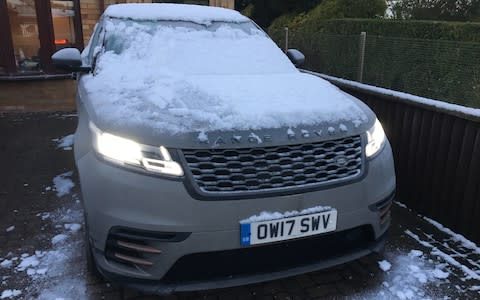
The heated seats and steering wheel were great, although the cool-looking twin screen set-up for all the various drive, info and entertainment controls looks better than it works. I’ll admit I was getting the hang of it all by the time it went back, but rival systems can be learned more quickly, and are easier in everyday operation.
A bit of digging around the settings did allow me in the final week to play around with the drive choices, the Dynamic one, which dials everything up to 11, denoted by an amusing crash helmet icon. To be totally honest, I never, ever, felt the need to change from the auto drive setting, which covers everything with such competence there’s little need to waver from it.
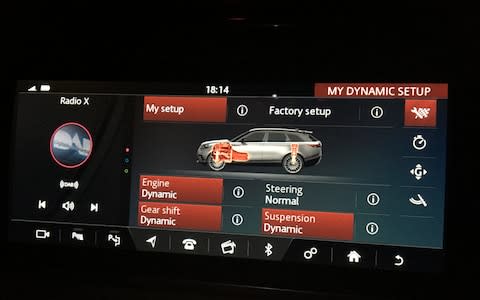
The 3.0-litre supercharged engine is never short of grunt, and the automatic transmission shifts so beautifully you can just leave it alone. Which is kind of the point.
A run to Wales in the holidays saw an opportunity to reset the trip meter and see if I could get better average consumption than the 19mpg or so the computer was showing. It did, significantly so, rising to 25.2mpg without being driven too conservatively, a week or so of the daily grind seeing that drop back to 24.6mpg. Decent enough, particularly given the potential performance.
I’ll blame the earlier readings on this Velar’s previous life on the press test fleet, being driven in performance tests by lead-footed road testers rather than real-world with a couple of kids in the back.
A diesel would, of course, have been better still, but over a month I didn’t find filling the Velar too painful at all.
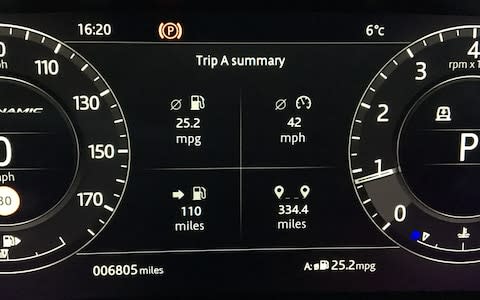
There were some niggles, the steering wheel buttons for volume control only worked on occasion, and before it went back I noticed the N on the bonnet badge was hanging off. I also found the lane- keeping blind-spot warning system a little bit to forceful in its action, being unnecessarily cautious when looking out for approaching traffic. I ended up, as with many of these things, switching it off and just checking my blind spot as I was taught to do when I learned to drive.
I’d not have chosen the cream interior, either, primarily because it was a car I’d be carrying children in, but also as after a month it’s apparent some of the dye from new jeans can discolour them - the driver’s seat having a hint of blue about it when it went back.
Mostly, it impressed, but I’d be keen to spend more time in a more representative model, as the £85,450 this Velar cost is pretty difficult to stomach. That puts it up against some very interesting rivals, not least the car with which I’ve replaced it with, which I’ll admit won’t be what you’re expecting…
December 18th, 2017
Fuel economy this week: 19.9mpg
Week two with the Velar and it’s settling in nicely. The snow has gone (well, at least all but the lump in the garden that was the snowman), so we’re back to the more usual winter motoring monotony with the Velar. Chiefly, defrosting it. I remember at its initial unveil, on a warm-ish day in spring, a few people asking about how well the pop-out door handles might work in the depths of winter. So far they have been fine, though other elements relating to the season have been a little less satisfactory.
Being the range-topping First Edition it comes with a heated windscreen, though unlike my wife’s old Ford Fiesta and C-Max it takes an age to clear frost from the screen. If I’m in a hurry, as I usually am when taking the kids to school, then I have to resort to the good old scraper. I use that on the side windows, too, as trying the old window-down-window-up routine results in a worryingly slow drop, if at all.
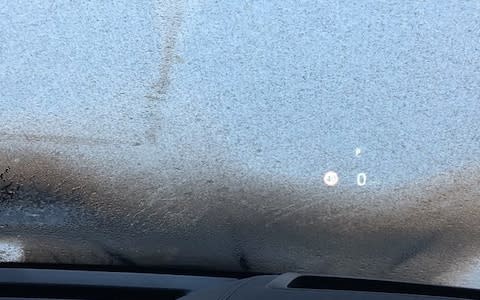
Then there are the washer jets, which have on two occasions now failed to work, being frozen in temperatures of around 0 to -1 desgrees. That’s not so untypical for the UK in winter, and meant a stop to clean the screen myself. I’ll give it a fill of some winter fluid and see if that helps, as I suspect it’s just been topped up with pure water previously; however, that sort of thing really shouldn’t happen these days.
The other issues, also winter-related, revolve around the driver assistance systems. I’ll admit that the Velar certainly isn’t alone here, as a Hyundai and a Mercedes-Benz I’ve had out recently have flagged up the same issues, but it’s a valid observation.
This morning the digital instrumentation flagged up that the Automatic Emergency Brake and Blind Spot Assist were not available due to the windscreen camera being obscured. Not the end of the world, admittedly, but as people become increasingly accustomed to such technology easing, or even taking over, elements of their driving then it’s a worry.
With the march of automation in our cars we could become even more enslaved by the winter weather, as such systems struggle to cope due to their need for sensors and cameras. Yes, the Velar still worked perfectly without them, though with 19.9mpg spotted on the average fuel consumption I’m doing my bit to make future winters warmer, too.

That consumption isn’t a surprise and, frankly it’s largely down to my heavy right foot. I’m sure it’d be a bit more parsimonious with someone else driving it, but the 3.0-litre supercharged V6 is one of those engines that goads you into pushing it hard.
The chassis seems pretty adept at dealing with it all, too, though even after a week I typically leave it in a single driving mode rather than messing about with the various options.
It’s comfortable, too, helped in no small part by the seats, which heat and massage beautifully. The heated steering wheel is excellent, too, though the fact the metal detail strip doesn’t heat up leaves a gold gap between the warm leather sections.
First world problems, I hear you say, and I’m inclined to agree with you. But in a luxury car - and particularly one at this price level - it’s all in the detail.
December 12th, 2017
Fuel economy this week: N/A
After the diminutive Up went back to Volkswagen I was at a bit of a loss with what to replace it with. Land Rover stepped up with the offer of a Range Rover Velar for six weeks, so now there’s one of those sitting outside where the little orange city car used to be.
Yes, it’s something of a diversion from my original goal of running long-term cars that aren’t what you’d traditionally consider "family" cars. It’s only for a short time, however, and as I missed the Velar launch it’s the first chance I’ve had to sample this much-anticipated car, which is how I’ve justified it to myself.
I’m only doing what everyone with kids does, too, and putting them in an SUV. I’ll be back on the non-family car theme with my next car.
The original plan was to have an HSE D240 model with the 2.0-litre turbodiesel, but the day before it was due to be delivered someone reversed into it. The replacement Land Rover sent was a bit more extreme, being the range-topping Velar First Edition P380, that 380 referring to its hp output, achieved via a supercharged 3.0-litre V6 petrol engine. Seems I’m following the zeitgeist and dropping diesel, then, and as it’s just for a few weeks I’ll stomach the fuel bills.
And the price? A not insubstantial £85,450. As the man from Land Rover pointed out, this won’t be where the bulk of Velar sales are, in the UK at least. It’s high enough to be firmly among the upper-end models of its bigger Range Rover Sport relation, as well the full-sized Range Rover itself. Not to mention that I could have nearly six VW Ups for that amount.

It had better be impressive, then. First impressions are good though, not least the styling, which is properly knock-out. Yes, the optional 22-inch alloy wheels are a little bit overt for my tastes, but that’s easy enough to change. That said, I’d retain the size, as having seen a few Velars on smaller wheels it’s clear it needs the larger rims.
To justify that price this is a Velar that wants for nothing. Indeed, if I listed the spec here you’d need a day to read it all. All that makes for a super-luxurious car; the heated, massaging seats and heated steering wheel a bonus because a few days after the car arrived it snowed.
The timing of the weather couldn’t have been more serendipitous, even if I’m always quick to remind people that it doesn’t matter how many wheels are driven if there’s no traction. That said, a quick run in the snow to collect our Christmas tree proved the white stuff was no trouble for the Velar’s sophisticated four-wheel drive system. I can also confirm a 6ft tree fits in easily enough. It also managed to go out for take-away pizza when they couldn’t deliver - not exactly a proper 4x4 Response rescue that we see all the time when the weather’s bad, but my kids appreciated it.
That said, there were plenty other cars without four-wheel drive that still managed to get around. Being a silly car journalist, I switched the Terrain Response setting to Dynamic (rather than the grass and snow setting which would be more sensible in such circumstances) and enjoyed it slithering around with more power going to the back wheels.
We’ll see how it fares as the weather improves and it gets used on more normal day-to-day drives, like the school run, trips to the airport for me and more besides. My biggest worry is how the white perforated leather interior is going to work with crumb-creating children in the back seats, and the potential fuel bills, but other than that I’m sure it’ll work out just fine.
For all the latest news, advice and reviews from Telegraph Cars, sign up to our weekly newsletter by entering your email here
More long-term tests



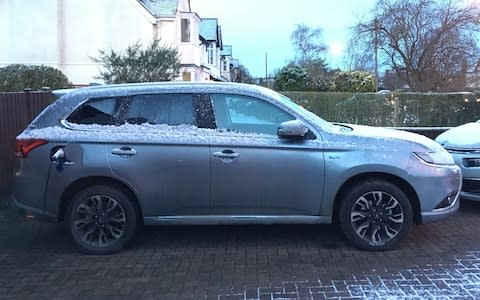

 Yahoo News
Yahoo News 